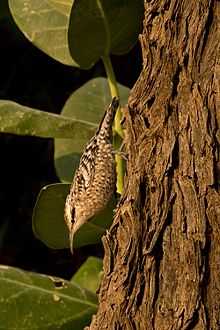Indian Spotted Creeper
| Indian Spotted Creeper | |
|---|---|
 | |
| Individual at Tal Chhapar Sanctuary, Rajasthan | |
| Conservation status | |
| Scientific classification | |
| Kingdom: | Animalia |
| Phylum: | Chordata |
| Class: | Aves |
| Order: | Passeriformes |
| Family: | Certhiidae |
| Subfamily: | Salpornithinae |
| Genus: | Salpornis |
| Species: | S. spilonotus |
| Binomial name | |
| Salpornis spilonotus (Franklin, 1831) | |

The Indian Spotted Creeper (Salpornis spilonotus) is a small passerine bird, which is a member of the subfamily Salpornithinae of the treecreeper family Certhiidae. It is found in northern India in open deciduous forest and mango groves. It does not migrate other than local movements.
The Indian Spotted Creeper has strongly spotted and barred plumage, clearly different from the treecreepers of the subfamily Certhiinae. It weighs up to 16 grams, twice as much as treecreepers of similar length (up to 15 cm).
The Indian Spotted Creeper has a thin pointed down-curved bill, which it uses to extricate insects from bark, but it lacks the stiff tail feathers which the true treecreepers use to support themselves on vertical trees.
Its nests and eggs are quite different from those of the Certhiinae. The nest is a cup placed on a horizontal branch, usually in a crotch, and camouflaged with spiders' egg sacs, caterpillar frass, and lichen. The clutch is usually two eggs, which are greenish or gray, spotted darker brown and blotched pale.
The African Spotted Creeper was formerly considered conspecific. Together they were called Spotted Creeper.
In addition to the treecreeper family, there are two other small bird families with 'treecreeper' or 'creeper' in their name – the Australian treecreepers and the Philippine creepers.
References
- ↑ BirdLife International (2012). "Salpornis spilonotus". IUCN Red List of Threatened Species. Version 2012.1. International Union for Conservation of Nature. Retrieved 16 July 2012.
- Mead, Christopher J. (2003). "Holarctic Treecreepers". In Perrins, Christopher. The Firefly Encyclopedia of Birds. Firefly Books. pp. 538–540. ISBN 1-55297-777-3.
